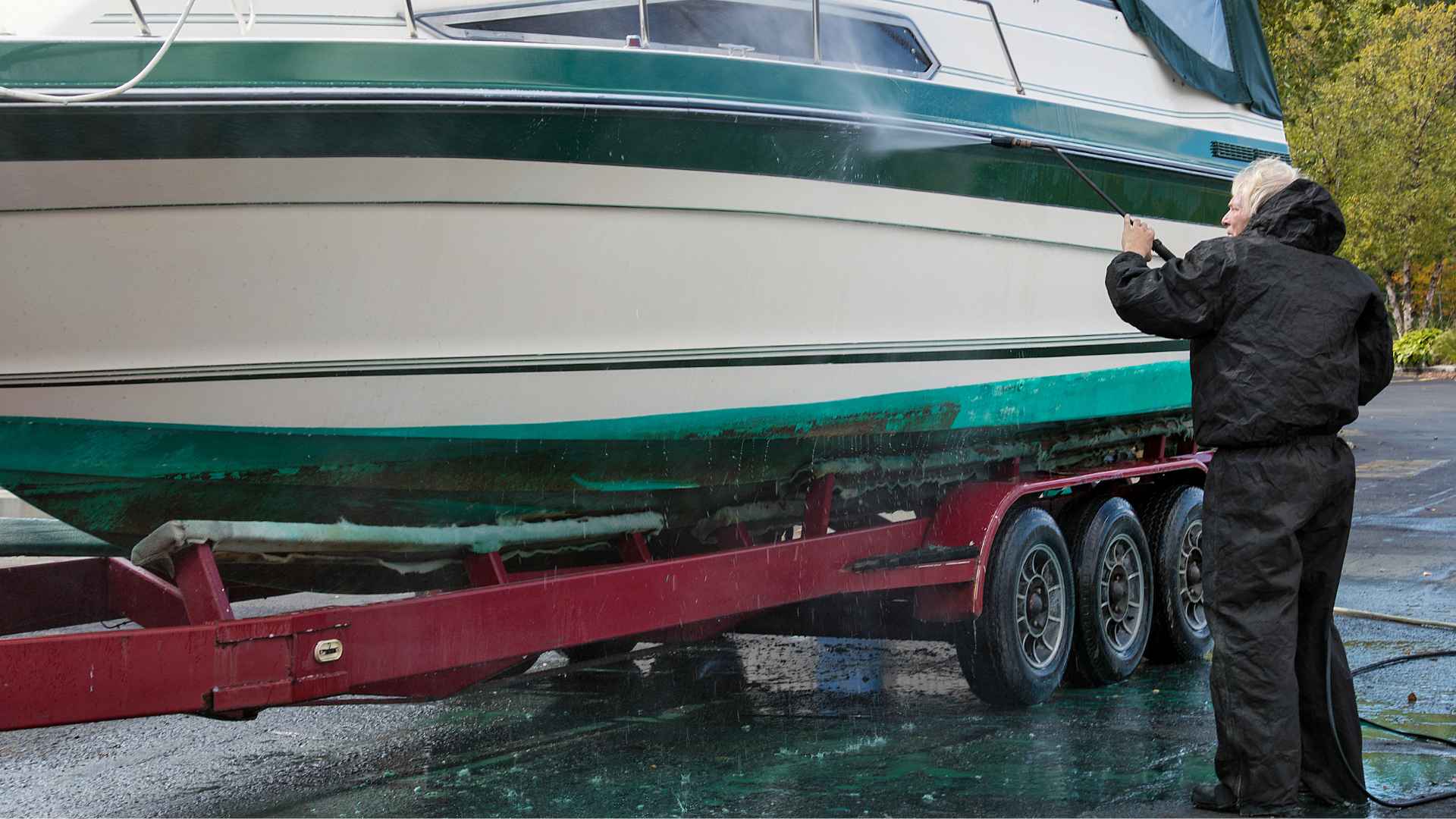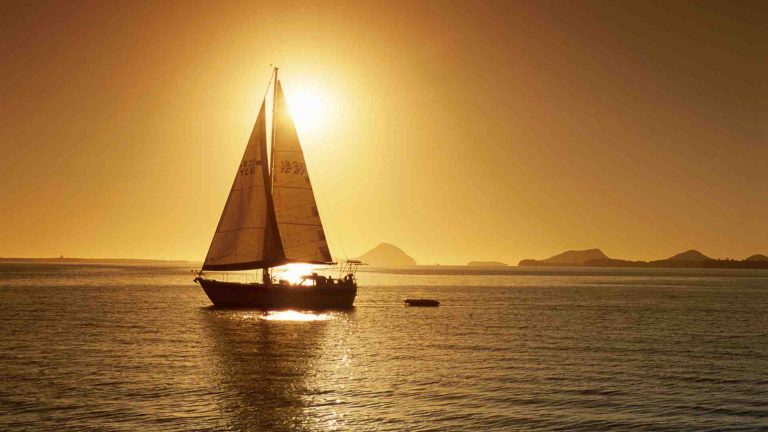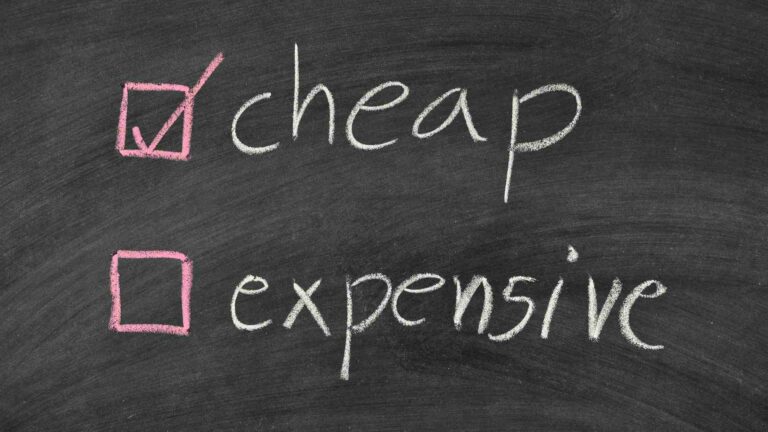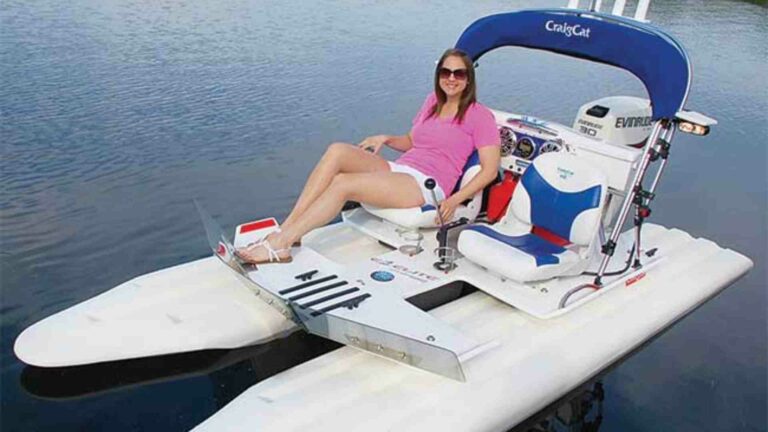What are chines on a boat – What are the Differences
Discover what chines on a boat are, their types, and how they impact stability, speed, and handling. Learn the differences and benefits in this detailed guide.
In the world of boating and naval architecture, the term “chine” is a critical yet often misunderstood feature of a boat’s hull. A chine is the intersection where the bottom of a boat’s hull meets its sides, creating a distinct angle or edge that significantly influences the vessel’s performance. Whether you’re a seasoned boater, a prospective buyer, or a marine enthusiast, understanding chines is essential for appreciating how boats handle, perform, and remain stable in various water conditions. This article explores the concept of chines, their types, their impact on boat design, and the differences between them, providing a comprehensive guide to this fundamental aspect of naval architecture.
What Is a Boat Chine?
A chine is defined as the sharp change in angle in the cross-section of a boat’s hull, where the bottom meets the sides. This feature runs parallel to the keel, the boat’s central spine, and can be observed when viewing the vessel from the front or rear. The chine is not just a structural element; it plays a pivotal role in determining how a boat interacts with water, affecting its stability, maneuverability, and efficiency.
Chines are found on many types of vessels, from small recreational boats to larger ships, but not all boats have them. For instance, canoes and yachts often feature curved hulls without distinct chines, designed for specific purposes like gliding smoothly or navigating at various angles. In contrast, boats with chines are engineered for stability, speed, or cargo capacity, depending on their design.
Why Chines Matter
Chines are integral to a boat’s performance for several reasons:
- Wave Handling: A well-designed chine allows a boat to cut through waves more effectively, reducing pounding and ensuring a smoother ride.
- Turning and Maneuverability: Chines help a boat lean into turns, providing better control and stability during high-speed or sharp maneuvers.
- Stability: The shape and type of chine influence how stable a boat remains, especially in rough waters or when planing (riding on top of the water).
- Speed and Efficiency: Chines, particularly in planing boats, reduce drag and enhance lift, allowing the vessel to achieve higher speeds with less resistance.
Understanding the role of chines is crucial when selecting a boat, as their design directly impacts the vessel’s suitability for specific activities, such as fishing, cruising, or high-speed racing.
Types of Boat Chines
Boat chines come in various forms, each with distinct characteristics that cater to different boating needs. The three primary types are hard chines, soft chines, and reverse chines, with variations like multi-chine and V-chine hulls also prevalent in modern designs.
Hard Chine
A hard chine is characterized by a sharp, distinct angle between the hull’s bottom and sides, forming a clear edge. This design is common in boats built for speed and stability, such as:
- Plywood boats
- Aluminum boats
- High-speed powerboats
- Fiberglass designs mimicking traditional workboats
Advantages:
- Increased Lift: The flat surfaces of hard chines provide significant lift, enabling the boat to plane quickly and maintain stability at high speeds.
- Interior Space: The angular design maximizes interior volume, making it ideal for boats requiring ample storage or passenger space.
- Responsiveness: Hard chines enhance maneuverability, allowing boats to bank tightly during turns.
Disadvantages:
- Rough Ride: In choppy waters, hard chines can cause a boat to pound, leading to a less comfortable ride.
- Stress Concentration: The sharp angles concentrate stress, potentially leading to wear and tear over time.
Applications: Hard chines are popular in bass boats, jon boats, and high-speed powerboats where speed and responsiveness are priorities.
Soft Chine
A soft chine features a gradual, rounded transition between the hull’s bottom and sides, creating a smoother curve rather than a sharp edge. This design is often seen in:
- Sailboats
- Canoes
- Traditional wooden ships
Advantages:
- Smoother Ride: Soft chines absorb wave impact better, providing a more comfortable experience in rough conditions.
- Easier Construction: The rounded design is simpler to manufacture, especially in wooden or fiberglass boats.
- Stability in Roll: Soft chines allow a boat to roll gently and return to an upright position, reducing the risk of capsizing.
Disadvantages:
- Reduced Planing Efficiency: Soft chines offer less lift, making them less suitable for high-speed planing.
- Less Responsive Turns: The rounded design doesn’t bank as sharply, which can affect maneuverability.
Applications: Soft chines are ideal for sailboats, canoes, and cruising vessels where comfort and stability in varied conditions are prioritized.
Reverse Chine
A reverse chine is a modern innovation where the chine angles downward at the stern, creating a lip that presses against the water. This design is increasingly popular in boats built for stability and control, such as those manufactured by brands like Liquid Metal Marine or Haines Hunter (e.g., the Haines Hunter V19R).
Advantages:
- Enhanced Stability: The downward angle creates pressure against the water, stabilizing the boat, especially in rough conditions or during turns.
- Reduced Spray: Reverse chines deflect water away from the boat, keeping the deck drier and improving passenger comfort.
- Improved Turning: The design enhances control during high-speed maneuvers, making turns more predictable.
Disadvantages:
- Fuel Consumption: The added resistance from reverse chines can increase fuel usage, particularly during long-distance cruising at high speeds.
- Harder Ride: The water’s impact against the reverse chine can result in a slightly rougher ride in certain conditions.
Applications: Reverse chines are common in fishing boats and offshore vessels designed for stability in challenging waters.
Multi-Chine and V-Chine Hulls
Modern boat designs often incorporate multi-chine or V-chine hulls to combine the benefits of hard and soft chines:
- V-Chine Hull: Features a pronounced V-shape at the bottom, providing improved handling but reduced stability. These are rarely used due to their instability but are simple to construct.
- Two-Chine Hull: Consists of a flat bottom with 90-degree angled sides, offering excellent stability and ample cargo space. This design is prevalent in cargo ships and heavy-duty vessels.
- Three-Chine Hull: The most common modern design, featuring a wide V-shape extending from the keel with sides angled over 90 degrees. This configuration balances stability, speed, and wave-handling capabilities, making it ideal for larger ships operating in rough conditions.
Chart: Comparison of Chine Types
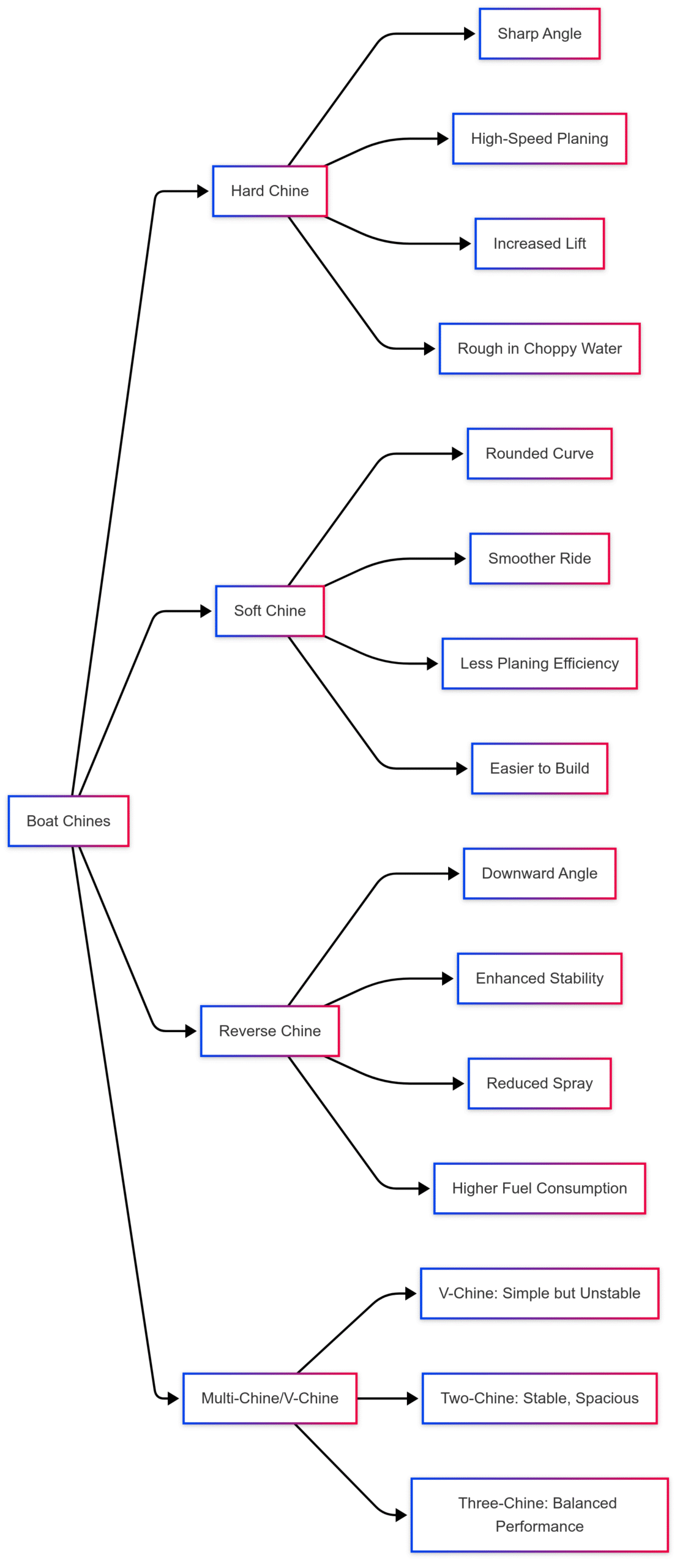
Chine Walking: A Performance Consideration
A phenomenon known as chine walking can occur in high-performance boats, particularly those with deep V-hulls and hard chines. When a boat planes at high speeds, it may rock from side to side due to the chines dipping unevenly into the water. This oscillation, if not corrected, can make the boat uncontrollable. To mitigate chine walking:
- Throttle Back: Reducing speed to idle stabilizes the boat.
- Steering Correction: Quick, precise steering adjustments can counteract the rocking motion.
Chine walking is a critical consideration for high-speed boaters, as it underscores the importance of chine design in maintaining control.
Which Boats Don’t Have Chines?
Not all boats feature chines. Vessels with curved or rounded hulls, such as:
- Canoes: Designed with a curved underbelly for agility and smooth gliding.
- Yachts: Built with curved hulls to navigate at various angles, prioritizing speed and comfort.
- Traditional Fishing Trawlers and Viking Boats: Often feature rounded hulls for stability and ease of construction.
These designs sacrifice the stability provided by chines for other performance characteristics, such as maneuverability or a smoother ride in specific conditions.
The Role of Chines in Boat Safety
Chines significantly contribute to a boat’s safety by enhancing stability and control. A well-designed chine helps keep a vessel upright, even in choppy waters, by providing lift and reducing the risk of capsizing. However, several factors influence a chine’s effectiveness:
- Vessel Size: Larger boats with chines can handle rougher conditions due to their mass and hull design.
- Deadrise Angle: The angle between the hull bottom and a horizontal plane affects stability and wave handling. A steeper deadrise (common in deep V-hulls) improves wave cutting but may reduce stability, while a flatter deadrise enhances stability but increases pounding.
For boat buyers, understanding the type of chine and its alignment with the vessel’s intended use is crucial for ensuring safety and performance.
Historical Evolution of Boat Chines
The concept of chines has evolved significantly over time. Early boats, such as dugout canoes, featured rounded bottoms due to their construction from hollowed-out logs. These rudimentary designs lacked distinct chines, making them less efficient for planing or high-speed travel. As boatbuilding techniques advanced, the introduction of planked hulls—consisting of a keel (spine) and ribs (frames)—allowed for more structured designs with soft chines.
The development of hard chines marked a significant leap forward, driven by the need for boats that could plane efficiently. The advent of the deep V-hull in the 20th century, paired with powerful engines, further refined chine design. Hard chines with small flat sections were introduced to stabilize these high-speed vessels, leading to the modern V-bottom design. More recently, reverse chines and multi-chine hulls have emerged, offering tailored solutions for stability, speed, and comfort.
Chine Construction Methods
The construction of chines varies depending on the hull material and design:
- Hard-Chine Construction:
- Uses angled panels of marine plywood or aluminum.
- Joins bottom panels to sides, sealed with fiberglass tape.
- Employs hardeners to stiffen the chine, enhancing structural integrity.
- Soft-Chine Construction:
- Requires precise bending of planks or curved panels.
- Often involves steam bending or soaking wood to shape around forms.
- Uses internal framing to support the curved hull.
- Fiberglass Chines:
- Molded shapes allow for versatile chine designs.
- Female molds create rounded sections, while male molds produce harder chines.
- Provides a rigid, unified structure with homogeneous stiffening.
These methods influence the cost, complexity, and durability of the boat, with hard chines being simpler and more cost-effective for amateur builders.
Choosing the Right Chine Design
Selecting the appropriate chine design depends on the boat’s intended use:
- High-Speed Powerboats: Hard chines for quick planing and responsiveness.
- Cruisers and Trawlers: Semi-displacement or soft chines for comfort and stability.
- Sailboats and Canoes: Soft chines for smooth handling and ease of construction.
- Offshore Race Boats: Variable deadrise or multi-chine hulls for optimized performance.
- Cargo Ships: Two-chine hulls for stability and cargo capacity.
Table: Chine Design Suitability
| Chine Type | Best For | Key Benefits | Drawbacks |
|---|---|---|---|
| Hard Chine | Powerboats, Bass Boats | Quick planing, Responsive turns | Rough ride in choppy water |
| Soft Chine | Sailboats, Canoes | Smooth ride, Easy construction | Less planing efficiency |
| Reverse Chine | Fishing Boats, Offshore Vessels | Enhanced stability, Reduced spray | Higher fuel consumption |
| Two-Chine Hull | Cargo Ships | High stability, Spacious interior | Limited maneuverability |
| Three-Chine Hull | Modern Ships, Rough Conditions | Balanced performance, Wave handling | Complex construction |
Advanced Chine Concepts
Modern boat designs incorporate advanced chine features to optimize performance:
- Chine Logs: Structural members in wooden boats that reinforce the chine, enhancing durability.
- Multi-Angle Chines: Combine multiple chine angles for tailored performance, common in high-performance vessels.
- Lifting Strakes vs. Chines: Lifting strakes are longitudinal protrusions on the hull bottom that enhance lift and speed, distinct from chines, which define the hull’s side-bottom intersection. However, some chines (especially reverse chines) contribute to lift.
- Spray Rails: While chines can reduce spray, dedicated spray rails are separate protrusions designed specifically to deflect water, improving passenger comfort.
Recommended Products for Boat Maintenance
To maintain a boat’s hull and chines, consider the following products (prices are approximate and may vary):
- Better Boat Hull Cleaner ($24.99): Removes stains and grime from hulls, ensuring chines remain clean and efficient.
- Better Boat Aluminum Polish ($19.99): Polishes aluminum hulls, ideal for hard-chine boats to maintain appearance and reduce corrosion.
- Better Boat Marine Degreaser ($17.99): Cleans grease and oil from hull surfaces, enhancing performance and longevity.
- Better Boat Scrub Set ($14.99): Includes brushes for scrubbing chines and hulls, ensuring thorough maintenance.
These products are essential for keeping chines in optimal condition, reducing drag, and extending the boat’s lifespan.
Conclusion
Chines are a cornerstone of boat design, influencing stability, speed, and handling. Whether it’s the sharp angles of a hard chine, the smooth curves of a soft chine, or the innovative downward angle of a reverse chine, each type serves a specific purpose tailored to different boating needs. From high-speed powerboats to stable cargo ships, chines play a critical role in determining a vessel’s performance and safety. By understanding the differences between chine types and their applications, boaters can make informed decisions when selecting or maintaining a vessel. As naval architecture continues to evolve, chines remain a fundamental element, ensuring boats are safe, efficient, and ready for the water.
For those looking to purchase a boat, consult trusted dealers like Alberni Power & Marine in Port Alberni, BC, for guidance on selecting the right chine design for your needs. Regular maintenance, using products like Better Boat’s hull cleaners, will keep your vessel’s chines in top shape, ensuring countless enjoyable adventures on the water.
Share What are chines on a boat – What are the Differences with your friends and Leave a comment below with your thoughts.
Read What Are the Parts of a Sailboat and What They Do? Guide until we meet in the next article.
